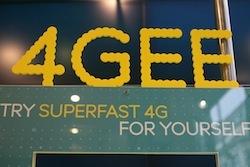For a company so used to shouting about itself, whether it’s through the actor Kevin Bacon or its bright cyan branding, EE is uncharacteristically cagey about its forthcoming VoLTE launch.
This week, Mobile Europe visited a test lab – an unmarked building on the outskirts of London – to learn about it and its VoWi-Fi service, which launches this autumn.
The building is a largely windowless maze of test rooms full of the latest core and radio technology, as well as some equipment dating back some 20 years. The VoLTE demonstration takes place in a small room hidden away at the back of three massive air conditioning units, which cool the army of cabinets used at the centre. Worryingly, the door can be locked from the outside.
While other operators have come to market with VoLTE and VoWi-Fi services, EE is likely to be the first operator in the UK to launch them, unless Three beats it to the punch with its wi-fi calling app InTouch, which comes to market in August.
According to research from Analysys Mason, operator IP voice services will account for 25.6 billion minutes of voice calls in the UK by 2018, or 20.2 percent of all calls made.
Analysys Mason’s Martin Scott says: “It is important that operators move to IP voice, which includes both VoLTE and VoWiFi, in order to control costs, defend and differentiate against OTT voice services such as Skype, and it improves the voice experience.”
A team of 50 EE engineers is set to test VoLTE, with a further 450 people joining it before the service is launched next year.
The operator plans to use the 800MHz spectrum it bought in the UK auction last year, which has greater indoor penetration than the 1800MHz it has already launched 4G LTE on.
VoLTE users will consume around 100KB of data per second but any calls made will come out of a customer’s voice allocation. Call connection time will take around one second, compared to between seven and eight seconds currently.
Tom Bennett, EE’s Director of Network Services, describes the VoLTE launch as the most complex project he has ever worked on: “When we introduced 4G, there were seven new systems. To introduce VoLTE, it’s 17 new systems and 74 new interfaces.”
VoLTE uses IMS capabilities, which Bennett says potentially opens it up to a range of new richer communication services, although he was coy about just what these could be.
Oxfordshire, in the south of England, will be the test bed for VoLTE, with 4G LTE being brought to an unconnected part of the countryside.
However, VoWi-Fi will come first. Like VoLTE, it will be native to compatible handsets. All they will need is a firmware upgrade and then customers can make high-definition calls.
EE says the service will be targeted at offices and those who have poor indoor coverage. Bennett notes that while 800MHz has high penetration, it still has trouble punching through a lot of buildings in London’s Canary Wharf financial district.
VoWi-Fi aims to overcome this, with the operator handing over to a macro cell when a customer moves out of range. However, it is unlikely for EE to follow the lead of rival O2, who has set up its own wi-fi network across the UK. Bennett says the network will also monitor quality of service across various public wi-fi networks and block those it does not feel is up to scratch.
So why is it being launched ahead of VoLTE? Bennett says the key concern is EE’s 4G coverage. It wants to bring next generation mobile to more than 90 percent of the population before the VoLTE service goes live.
However, the operator says that because the service is native and free to 4G customers with compatible handsets, it will not make as much of a splash as it did with 4G.
This begs the question why they are doing it at all but Bennett says the aim is to improve voice coverage. It is aiming for a dropped call rate of 0.5 percent across the UK by the end of this year – it currently sits at around 0.6 percent.
It has already trialled what it is calling the “Platinum Project” in Derby, which gives residents and businesses a dropped call rate of 0.4 percent.
EE is looking at M25 Orbital, Canary Wharf and the Southbank in London as its next Platinum Project areas. Its new MyEE app will also identify blackspots in coverage by tracking dropped calls.
Coupled with this are the latest steps in its network improvement project. Around £275 million will be spent this year to remove legacy equipment, update hardware and improve coverage.
More than 6,000 2G masts have had new equipment installed during the past year and a half, with more than 2,000 3G masts seeing their capacity doubled.
In addition, the operator is testing IPv6, which will solve the need for more IP addresses as more and more connected devices go online.
Bennett says: “As a mobile industry, voice over IPv4 is approaching exhaustion. That trend will continue as we have more IP addresses than ever before. IMS, as a new service, requires new IP addresses. It’s not devices, it’s services on the device. That’s the step change.”
Which illustrates the need for the test centre in Borehamwood. Bennett is blunt about the challenges in making a network operate. He says that there are more than 30,000 configurable parameters in a 3G handset. There are even more on a 4G device.
“Things go wrong… the mobile phone is the most technologically complex consumer product of all time,” he says.




